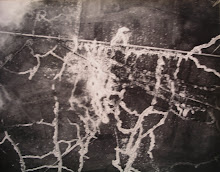Oxford 28-2-09: additional note.
Imaging Golgotha – Aerial Photos and Trench Maps of the Western Front. Dr Peter Chasseaud
Why do we need the Western Front landscape? A mythical landscape.
We must recognise that we are all involved in the process of creating a new mythology. As Nietzsche said, history is all about interpretation. There is, of course, a myriad of interpretations.
I am today looking at the creation, during the First World War, of a conceptual and representational paper landscape which has now, for us, become a simulacrum of the ‘real’ conflict landscape of 1914-18. We recognise that landscape is a human construction, the result of thousands of years of cultivation and industry. The war landscape has the humans all mixed up in it (literally), and walking all over it. Those of us who today walk the same geographical landscape, in the full knowledge that the 14-18 war, and the intervening years, have changed that landscape, also have to acknowledge that the past is a foreign country which we do not want to let go – indeed in some way we need to hang on to it, reclaim it or redefine it, as a way of defining our own identity. It also represents, as something we did not do, a continual challenge, a sort of perpetual St Crispin’s Day: ‘What did you do in the Great War, Daddy?’ becomes for us ‘What would you have done in the Great War . . . ?, or as one speaker I recently heard put I, ‘I hope I would cut the mustard’. There is here also an element of ancestor worship, a quasi religious element. For some it has become a dubious emotional catalyst – notably on the ‘big days’ such as 1st July, 31st July, 11th November.
We are creating this myth as part of the continuum of myth-making that was going on since August 1914, and which we can recognise in the memoirs of Graves, Sassoon, Blunden and many others, and especially in the works of David Jones. It was Jones above all who, in the period 1932-7, during the creation of In Parenthesis, consciously and explicitly designated the Western Front (and, more locally, Plugstreet) as Broceliande – the enchanted forest or mythical landscape. Across no man’s land was the strange, alien territory of the enemy, where things look and smell different, where shadows flit and ghosts and vampires lurk.
We need that mythology in a way that France or Germany do not. They were fighting for national survival, and their predominantly peasant populations were not (until briefly with Hitler and Pétain) that interested in the creation of a new mythical landscape; in any case they had their heads and hands full of the old one. But for Britain it was foreign and strange, and especially for the mainly urban, industrial civilian soldiers it was a revelation, indeed an epiphany of a sort. And from the 1960s, as we lost an empire, we needed something new to believe in, and that was some defining myth which touched every family more deeply that the more recent war of 1939-45 (around which myths were also created – Dunkirk, the Battle of Britain, the Blitz, etc., but because it more directly impacted the civilian population at home somehow diffused the experience).
Wednesday, 1 April 2009
Subscribe to:
Post Comments (Atom)

No comments:
Post a Comment